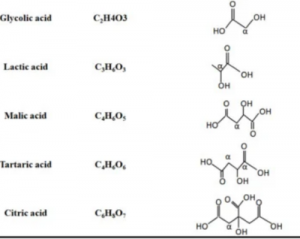The Power of Alpha Hydroxy Acids (AHA) in Skincare Products
Introduction
The skincare industry has witnessed a whirlwind of change, especially with the rise of Alpha Hydroxy Acids (AHAs) and their remarkable effects on skin health. It is said that Cleopatra indulged herself in sour milk (lactic acid) baths for radiant skin. This is a historic nod to the potential of AHAs. Recently, these acids have created a buzz in the beauty and cosmetic realm as well. Let’s have a detailed discussion about their properties and benefits.
What are alpha hydroxy acids?
AHAs are a group of naturally occurring acids primarily derived from fruits and milk sugars. These acids are well-known for their ability to exfoliate the skin and promote skin cell turnover. Here’s a glimpse of some of the top Alpha Hydroxy Acids:

Structures of Different AHAs [1]
- Lactic Acid: It is an exceptional exfoliant and potent moisturizer. It often comes from non-dairy sources like plants.
- Glycolic Acid: Glycolic acid is derived from sugar cane and fruits. It immediately softens the skin upon application.
- Citric Acid: The source of citric acid is from citrus fruits. It aids collagen function and is crucial for skin elasticity.
- Malic Acid: It is found in apples. It enhances skin elasticity, so it is ideal for homemade skincare.
- Tartaric Acid: This acid is extracted from grapes and citrus fruits. It enhances skin flexibility and has become a popular choice in AHA skincare.
Related reading: The Secrets of Skincare: Glycolic Acid, Lactic Acid, and Hyaluronic Acid
How do AHA exfoliants work for the skin?
AHA exfoliants work by loosening and removing dead skin cells from the skin’s surface. They can penetrate the skin’s outermost layer, revitalize the skin, and impart a youthful radiance. Users often report several noticeable benefits:
- Exfoliation: AHAs work by breaking down the bonds between dead skin cells on the outermost layer of the skin (epidermis). This chemical exfoliation helps reveal fresher, smoother, and brighter skin underneath.
- Promotion: AHAs promote skin cell turnover because new skin cells are produced and brought to the skin’s surface. This turnover helps in maintaining healthier-looking skin and improving its texture.
- Collagen Production: Some AHAs, such as glycolic acid, have been found to stimulate collagen production in the skin. Collagen provides structure and firmness to the skin.
- Hydration: AHAs can also improve the skin’s ability to retain moisture. These acids can assist in maintaining a hydrated and smoother skin surface.
Is there any FDA research on the safety of AHAs?
In the short term, excessive doses and improper usage of AHA-containing skincare products may result in adverse reactions. Between 1992 and February 2004, there were 114 reported cases. They detail various dermatologic experiences associated with these products. The most frequently reported reactions included burning sensations (45), rash or dermatitis (35), swelling (29), pigmentary changes (15), and blisters (14). [2] Therefore, it is necessary to follow proper usage guidelines and dosage recommendations when integrating AHAs into skincare regimens.
In the long term, the FDA collaborated with the National Toxicology Program (NTP) to assess the safety of prolonged AHA use. Their study revealed that glycolic acid, an AHA, did not induce the development of cancer cells in mice. Additionally, salicylic acid, another common AHA, safeguarded mice against the effects of light exposure. [2] These findings contribute to a broader understanding of the safety profile associated with extended AHA usage.
How can AHAs be used safely?
When it comes to Alpha Hydroxy Acids, proper usage is crucial. Generally, AHA ingredients range from 1% to 2% for daily products. For more intensive treatments, 5% to 10% AHA concentration should suffice. However, these products should be used judiciously. The frequency should be limited to once a week.
Using products containing AHAs may increase the skin’s sensitivity to the sun. Hence, to safeguard against such potential adverse effects, it’s recommended to use a broad-spectrum sunscreen daily. You’d better choose a sunscreen with a high SPF. This precautionary measure helps minimize the risk of sun damage and supports overall skin health when using AHAs regularly.
Which ingredients work well with AHAs?
When incorporating AHAs into your skincare routine, it’s essential to be cautious about mixing them with certain active ingredients to prevent adverse reactions. Compatible ingredients include hydrating elements like hyaluronic acid or moisturizing agents such as ceramides and glycerin. Nevertheless, it’s important to avoid combining AHAs with retinoids, benzoyl peroxide, or other exfoliants to prevent skin irritation or over-exfoliation. Always perform a patch test and introduce new products gradually to ensure compatibility and minimize the risk of any adverse reactions.
Related reading: Best Companions of Hyaluronic Acid for Skincare
Conclusion
In a word, AHAs stand out for their exfoliating prowess and offer a multitude of benefits for skin care. When used thoughtfully and in tandem with compatible ingredients, they can unlock a path to healthier, rejuvenated skin. Please use them with professional guidance to harness the transformative potential of AHAs while prioritizing skin safety and wellbeing.
Stanford Chemicals Company (SCC) provides a range of hyaluronic acid powder options. HA products tailored for specific skincare purposes are also available. Please check out our website for detailed information about different grades of HA products.
Reference:
[1] Tang S-C, Yang J-H. Dual Effects of Alpha-Hydroxy Acids on the Skin. Molecules. 2018; 23(4):863. https://doi.org/10.3390/molecules23040863
[2] U.S. Food and Drug Administration (2022, November 22). Alpha Hydroxy Acids. U.S. Food and Drug Administration. Retrieved November 29, 2023, from https://www.fda.gov/cosmetics/cosmetic-ingredients/alpha-hydroxy-acids#:~:text=product%20contains%20AHAs%3F-,Why%20are%20AHAs%20used%20in%20some%20cosmetics%3F,improving%20skin%20condition%20in%20general.
